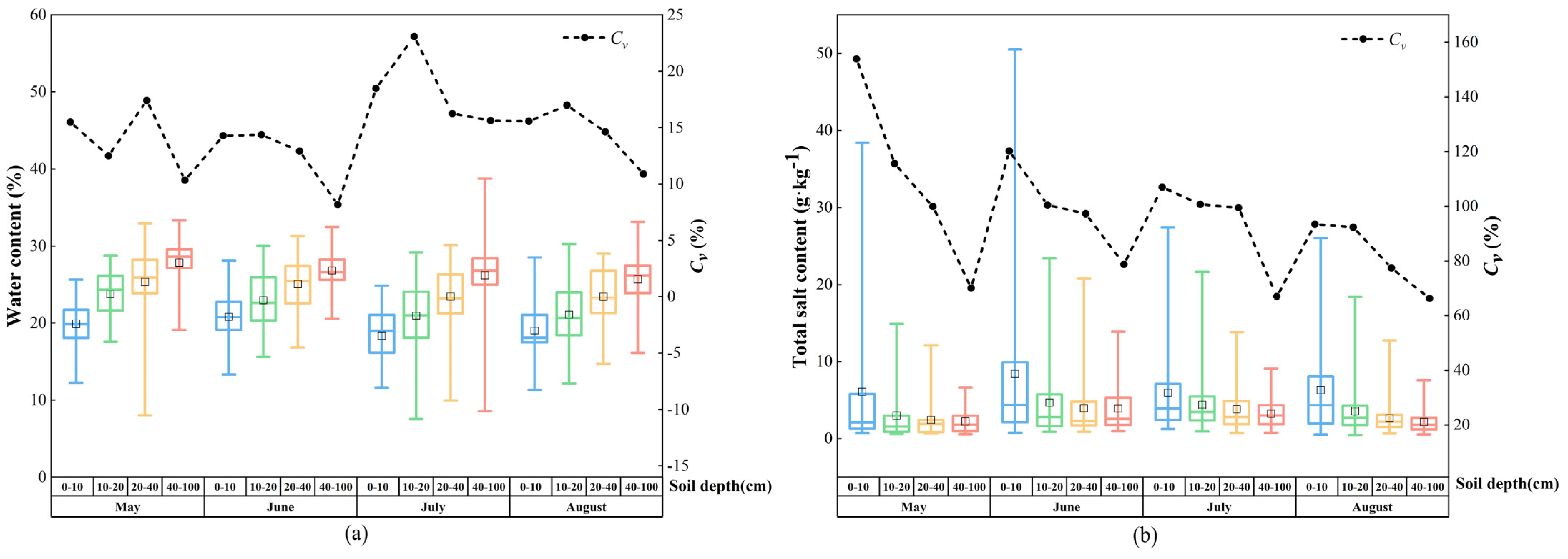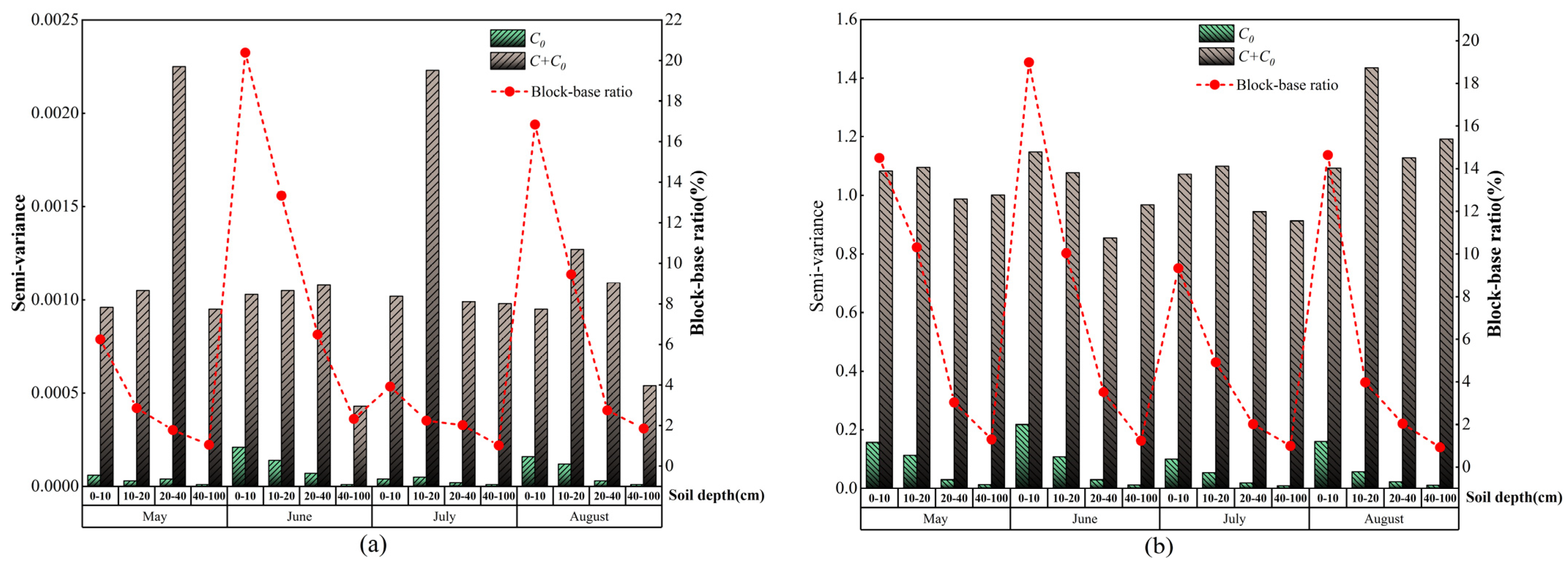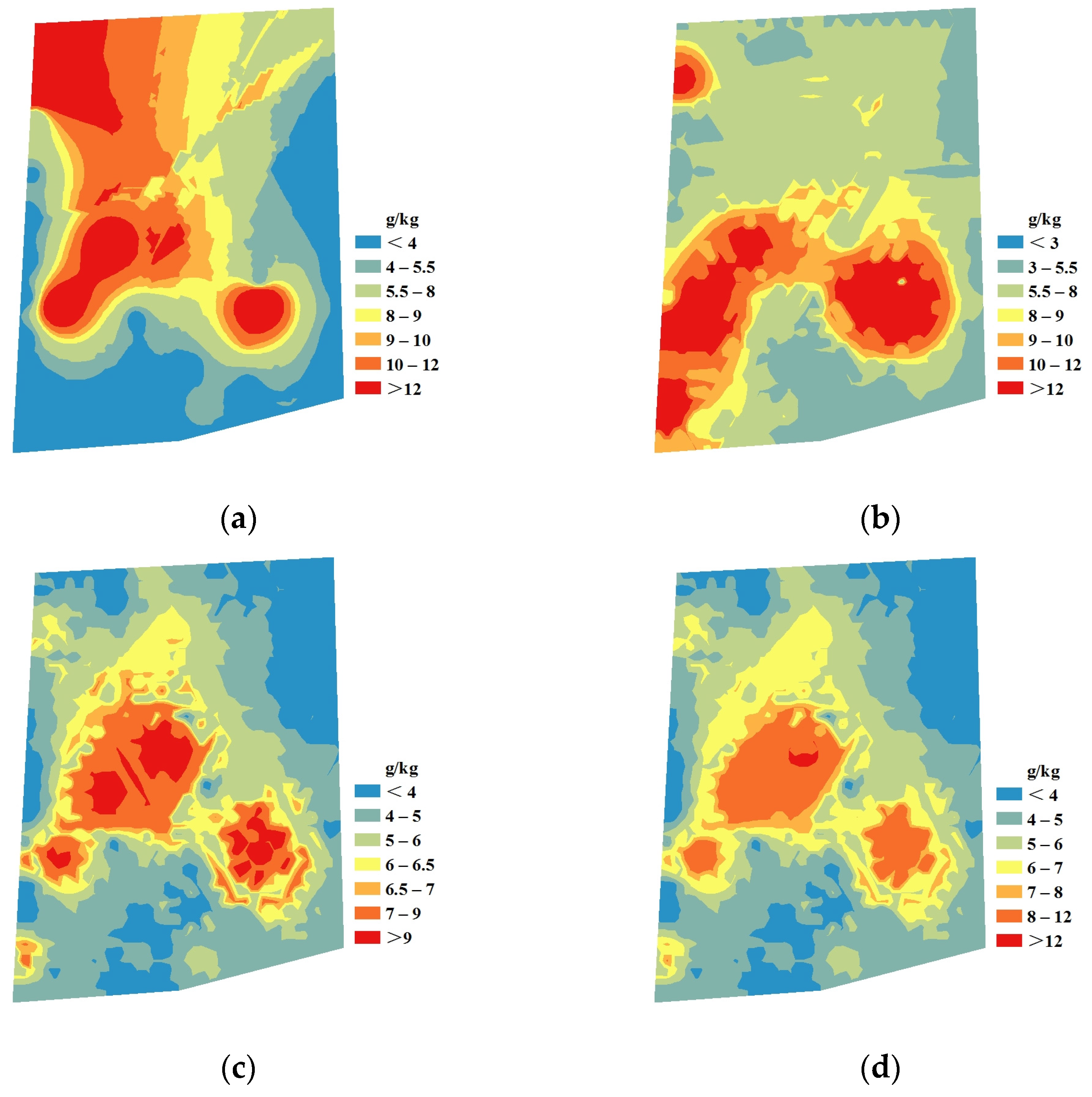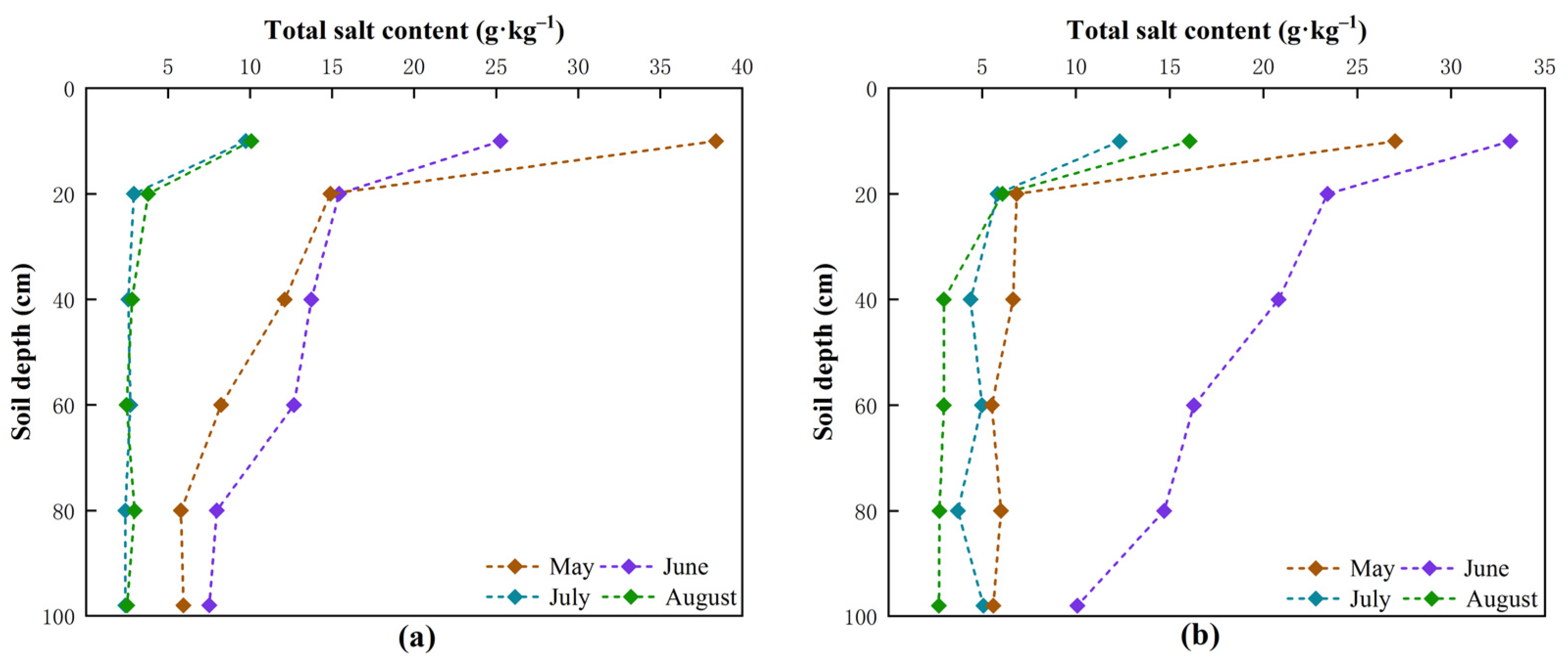Analysis of Spatial and Temporal Variability and Coupling Relationship of Soil Water and Salt in Cultivated and Wasteland at Branch Canal Scale in the Hetao Irrigation District
Abstract
:1. Introduction
2. Materials and Methods
2.1. Study Area
2.2. Experimental Design
2.3. Research Methodology
2.3.1. Soil Total Salt Content Calculation
2.3.2. Coefficient of Variation
2.3.3. Semi-Variance Function
2.3.4. Ordinary Kriging Interpolation and Radial Basis Functions Interpolation
2.3.5. Soil Salt Accumulation Rate and Desalination Rate Calculation
2.3.6. Soil Water and Salt Coupling Coordination Degree Model
2.4. Data Processing
3. Results
3.1. Statistical Characterization of Soil Water Content and Total Salt Content
3.2. Spatial Correlation Analysis of Soil Water Content and Total Salt Content of Each Soil Layer in Different Periods
3.3. Spatial Distribution Characteristics of Soil Salinity
3.4. Distribution Pattern of Soil Salinity in Cultivated and Wasteland
3.5. Soil Water–Salt Coupling Coordination Degree in Cultivated and Wasteland
4. Discussion
5. Conclusions
Author Contributions
Funding
Data Availability Statement
Conflicts of Interest
References
- Zhang, J.; Xiao, H. Past, Current and Future Prospect for Research on Agricultural Water Use in Irrigation Districts in the Yellow River Basin. J. Irrig. Drain. 2020, 39, 9–17. [Google Scholar] [CrossRef]
- Cao, Z.; Zhu, T.; Cai, X. Hydro-agro-economic optimization for irrigated farming in an arid region: The Hetao Irrigation District, Inner Mongolia. Agric. Water Manag. 2023, 277, 108095. [Google Scholar] [CrossRef]
- Zhang, H.; Xiong, Y.; Huang, G.; Xu, X.; Huang, Q. Effects of water stress on processing tomatoes yield, quality and water use efficiency with plastic mulched drip irrigation in sandy soil of the Hetao Irrigation District. Agric. Water Manag. 2017, 179, 205–214. [Google Scholar] [CrossRef]
- Guo, K.; Liu, X. Reclamation effect of freezing saline water irrigation on heavy saline-alkali soil in the Hetao Irrigation District of North China. CATENA 2021, 204, 105420. [Google Scholar] [CrossRef]
- Jiang, D.; Ao, C.; Bailey, R.T.; Zeng, W.; Huang, J. Simulation of water and salt transport in the Kaidu River Irrigation District using the modified SWAT-Salt. Agric. Water Manag. 2022, 272, 107845. [Google Scholar] [CrossRef]
- Mao, W.; Yang, J.; Zhu, Y.; Ye, M.; Wu, J. Loosely coupled SaltMod for simulating groundwater and salt dynamics under well-canal conjunctive irrigation in semi-arid areas. Agric. Water Manag. 2017, 192, 209–220. [Google Scholar] [CrossRef]
- Wang, X.; Zhang, H.; Zhang, Z.; Zhang, C.; Zhang, K.; Pang, H.; Bell, S.M.; Li, Y.; Chen, J. Reinforced soil salinization with distance along the river: A case study of the Yellow River Basin. Agric. Water Manag. 2023, 279, 108184. [Google Scholar] [CrossRef]
- Zhu, L.; Liu, Y.; Jiao, F. Time Series Analysis of Spatial Variability of Soil Moisture in Loess Hilly Region. Procedia Earth Planet. Sci. 2012, 5, 346–353. [Google Scholar] [CrossRef]
- Gu, X.; Han, J.; Zhang, F.; Zhang, D.; Liu, S. Spatial variability of soil salinity and its multi factor response in irrigation area. Bull. Soil Water Conserv. 2020, 40, 100–106. [Google Scholar] [CrossRef]
- Selmy, S.; El-Aziz, S.A.; El-Desoky, A.; El-Sayed, M. Characterizing, predicting, and mapping of soil spatial variability in Gharb El-Mawhoub area of Dakhla Oasis using geostatistics and GIS approaches. J. Saudi Soc. Agric. Sci. 2022, 21, 383–396. [Google Scholar] [CrossRef]
- John, K.; Abraham, I.I.; Kebonye, N.M.; Agyeman, P.C.; Ayito, E.O.; Kudjo, A.S. Soil organic carbon prediction with terrain derivatives using geostatistics and sequential Gaussian simulation. J. Saudi Soc. Agric. Sci. 2021, 20, 379–389. [Google Scholar] [CrossRef]
- Dou, X.; Shi, H.; Miao, Q.; Tian, F.; Yu, D.; Zhou, L.; Liang, Z. Temporal and spatial variability analysis of soil water and salt and the influence of groundwater depth on salt in saline irrigation area. J. Soil Water Conserv. 2019, 33, 246–253. [Google Scholar] [CrossRef]
- Barman, A.; Sheoran, P.; Yadav, R.K.; Abhishek, R.; Sharma, R.; Prajapat, K.; Singh, R.K.; Kumar, S. Soil spatial variability characterization: Delineating index-based management zones in salt-affected agroecosystem of India. J. Environ. Manag. 2021, 296, 113243. [Google Scholar] [CrossRef] [PubMed]
- Brocca, L.; Tullo, T.; Melone, F.; Moramarco, T.; Morbidelli, R. Catchment scale soil moisture spatial–temporal variability. J. Hydrol. 2012, 422–423, 63–75. [Google Scholar] [CrossRef]
- Feng, X.; An, P.; Li, X.; Guo, K.; Yang, C.; Liu, X. Spatiotemporal heterogeneity of soil water and salinity after establishment of dense-foliage Tamarix chinensis on coastal saline land. Ecol. Eng. 2018, 121, 104–113. [Google Scholar] [CrossRef]
- Yao, R.; Yang, J.; Liu, G.; Zhou, P. Spatial variability of soil salinity in characteristic field of the Yellow River Delta. Trans. Chin. Soc. Agric. Eng. 2006, 22, 61–66. [Google Scholar]
- Zhu, J.; Guo, S.; Yang, Y.; Li, P.; Zhang, Q.; Dai, Q.; Zhang, K. Temporal-spatial variability of soil salinity in greenspace of Tianjin Binhai Economic-Technological Development Area. Trans. Chin. Soc. Agric. Eng. 2016, 32, 161–168. [Google Scholar] [CrossRef]
- Bogunovic, I.; Trevisani, S.; Seput, M.; Juzbasic, D.; Durdevic, B. Short-range and regional spatial variability of soil chemical properties in an agro-ecosystem in eastern Croatia. CATENA 2017, 154, 50–62. [Google Scholar] [CrossRef]
- Fu, Z.; Wang, P.; Sun, J.; Lu, Z.; Yang, H.; Liu, J.; Xia, J.; Li, T. Composition, seasonal variation, and salinization characteristics of soil salinity in the Chenier Island of the Yellow River Delta. Glob. Ecol. Conserv. 2020, 24, e01318. [Google Scholar] [CrossRef]
- Liu, Y.; Sun, G.; Mao, W.; Cheng, X.; Zhu, Y.; Yang, J. Geostatistical Analysis of Spatial Variability of Soil Water and Salt in Hetao Irrigation District. J. Irrig. Drain. 2022, 41, 101–109. [Google Scholar] [CrossRef]
- Zhang, X.; Shu, C.; Wu, Y.; Ye, P.; Du, D. Advances of coupled water-heat-salt theory and test techniques for soils in cold and arid regions: A review. Geoderma 2023, 432, 116378. [Google Scholar] [CrossRef]
- Wang, Q.; Jin, H.; Yuan, Z.; Yang, C. Synergetic variations of active layer soil water and salt in a permafrost-affected meadow in the headwater area of the Yellow River, northeastern Qinghai–Tibet plateau. Int. Soil Water Conserv. Res. 2022, 10, 284–292. [Google Scholar] [CrossRef]
- Guo, Y.; Yin, X.; Li, Y.; Chen, Y.; Cui, M. Soil water and salt dynamics and its coupling model at cropland-treebelt-desert compound system. Trans. Chin. Soc. Agric. Eng. 2019, 35, 87–101. [Google Scholar]
- Luo, C.; Yu, Y.; Zhang, J.; Cui, W. Heat-Mass Transfer Test and Coupling Model of Sulfate Saline Soil. J. Southwest Jiaotong Univ. 2023, 58, 470–478. [Google Scholar] [CrossRef]
- Zhang, N. Study on the Spatial Variia Bility and Transform Techniques of Soil Hydraulic Parameters Iin Multi-Scaled Saline Irrigation Districts; Inner Mongolia Agricultural University: Hohhot, China, 2016. [Google Scholar]
- Wang, G.; Shi, H.; Li, X.; Guo, J.; Wang, W.; Wu, D. Estimation of Salt Transport and Relationship with Groundwater Depth in Different Land Types in Hetao Irrigation Area. Trans. Chin. Soc. Agric. Mach. 2020, 51, 255–269. [Google Scholar] [CrossRef]
- Tagore, G.S.; Sharma, G.D.; Kulhare, P.S.; Set, S.K. Characterization of Spatial Variability of Micro Nutrients in Soils: Classical Vs. Geo-Statistical Approach. Commun. Soil Sci. Plant Anal. 2023, 54, 472–487. [Google Scholar] [CrossRef]
- Deng, X.; Xu, X.; Wang, S. The tempo-spatial changes of soil fertility in farmland of China from the 1980s to the 2010s. Ecol. Indic. 2023, 146, 109913. [Google Scholar] [CrossRef]
- Shifteh-Some’e, B.; Hassanpour, F.; Ezani, A.; Miremadi, S.R.; Tabari, H. Erratum to: Investigation of spatial variability and pattern analysis of soil properties in the northwest of Iran. Environ. Earth Sci. 2012, 65, 401. [Google Scholar] [CrossRef]
- Yao, X.; Yu, K.; Deng, Y.; Liu, J.; Lai, Z. Spatial variability of soil organic carbon and total nitrogen in the hilly red soil region of Southern China. J. For. Res. 2020, 31, 2385–2394. [Google Scholar] [CrossRef]
- Zhang, D.; Jiang, B.; Liu, G.; Zhang, H.; Nie, F.; Sun, Q.; Ji, M. Applicability of spatial interpolation methods to predict total phosphorus in the typical irrigated areas of the Sanjiang Plain. Chin. J. Eco-Agric. 2021, 29, 1405–1416. [Google Scholar] [CrossRef]
- Chengjing, N.; Yixuan, L.; Linsheng, Y.; Li, W.; Fengying, Z. Spatio-temporal characteristics and coupling coordination relationship between urbanization and atmospheric particulate pollutants in the Bohai Rim in China. Ecol. Indic. 2023, 153, 110387. [Google Scholar] [CrossRef]
- Liu, H.; Ding, B.; Bai, Y.; Zhang, J.; Wang, S.; Huang, Z. Spatial Distribution character istics of Soil Salinity in an Oasis of Typical Arid Regions in Spring. Chin. J. Soil Sci. 2021, 52, 279–285. [Google Scholar] [CrossRef]
- Cambardella, C.A.; Moorman, T.B.; Novak, J.M.; Parkin, T.B.; Konopka, A.E. Field-Scale Variability of Soil Properties in Central Iowa Soils. Soil Sci. Soc. Am. J. 1994, 58, 1501–1511. [Google Scholar] [CrossRef]
- Zhang, X.; Xiang, D.-Q.; Yang, C.; Wu, W.; Liu, H.-B. The spatial variability of temporal changes in soil pH affected by topography and fertilization. CATENA 2022, 218, 106586. [Google Scholar] [CrossRef]
- Wang, Z.; Zhao, G.; Gao, M.; Chang, C. Spatial variability of soil salinity in coastal saline soil at different scales in the Yellow River Delta, China. Environ. Monit. Assess. 2017, 189, 80. [Google Scholar] [CrossRef]
- Chen, L.; Feng, Q.; Cheng, A. Spatial distribution of soil water and salt contents and reasons of saline soils’ development in the Minqin Oasis. J. Arid Land Resour. Environ. 2013, 27, 99–105. [Google Scholar] [CrossRef]
- Tripathi, R.; Nayak, A.K.; Shahid, M.; Raja, R.; Panda, B.B.; Mohanty, S.; Kumar, A.; Lal, B.; Gautam, P.; Sahoo, R.N. Characterizing spatial variability of soil properties in salt affected coastal India using geostatistics and kriging. Arab. J. Geosci. 2015, 8, 10693–10703. [Google Scholar] [CrossRef]
- Zhang, Z.; Yin, H.; Chang, J.; Xue, J. Spatial variability of surface soil water content and its influencing factors on shady and sunny slopes of an alpine meadow on the Qinghai–Tibetan Plateau. Glob. Ecol. Conserv. 2022, 34, e02035. [Google Scholar] [CrossRef]
- Wang, R.; Wan, H.; Chen, S.; Xia, Y.; Bai, Q.; Peng, Z.; Shang, S. Spatial distribution pattern of soil salinization in farmland of Wulate sub-irrigation areas in Hetao Irrigation District in Inner Mongolia in spring. Trans. Chin. Soc. Agric. Eng. 2021, 37, 105–113. [Google Scholar] [CrossRef]
- Li, L.; Shi, H.; Takeo, A.; Zhang, Y.; Liu, H. Transport of Soil Moisture and Salt between Irrigated Land and Saline Land in the Inner Mongolia Hetao Irrigation District. J. Irrig. Drain. 2010, 29, 73–77. [Google Scholar] [CrossRef]
- Wang, C.; Wu, J.; Zeng, W.; Zhu, Y.; Huang, J. Five-Year Experimental Study on Effectiveness and Sustainability of a Dry Drainage System for Controlling Soil Salinity. Water 2019, 11, 111. [Google Scholar] [CrossRef]
- Wang, G.; Shi, H.; Li, X.; Yan, J.; Akae, T. A Study on Water and Salt Transport, and Balance Analysis in Sand Dune–Wasteland–Lake Systems of Hetao Oases, Upper Reaches of the Yellow River Basin. Water 2020, 12, 3454. [Google Scholar] [CrossRef]








| Soils Layer (cm) | Soils Type | Soil Bulk Density (g·cm−3) | Field Moisture Capacity (%) | Saturated Water Capacity (%) |
|---|---|---|---|---|
| 0–10 | Silty loam | 1.55 ± 0.12 | 24.17 ± 0.04 | 28.63 ± 0.04 |
| 10–20 | Silty loam | 1.41 ± 0.09 | 29.72 ± 0.04 | 33.79 ± 0.04 |
| 20–40 | Silty loam | 1.44 ± 0.04 | 31.11 ± 0.03 | 35.53 ± 0.02 |
| 40–60 | Silt | 1.40 ± 0.02 | 31.32 ± 0.01 | 35.64 ± 0.01 |
| 60–80 | Silt | 1.33 ± 0.04 | 36.07 ± 0.02 | 40.73 ± 0.01 |
| 80–100 | Silt | 1.37 ± 0.02 | 33.06 ± 0.02 | 38.91 ± 0.03 |
| Coupling Coordination Degree D | Coordination Level |
|---|---|
| 0 < D ≤ 0.1 | Extreme disorder |
| 0.1 < D ≤ 0.2 | Serious disorder |
| 0.2 < D ≤ 0.3 | Moderate disorder |
| 0.3 < D ≤ 0.4 | Low disorder |
| 0.4 < D ≤ 0.5 | Marginal disorder |
| 0.5 < D ≤ 0.6 | Marginal coordination |
| 0.6 < D ≤ 0.7 | Low coordination |
| 0.7 < D ≤ 0.8 | Moderate coordination |
| 0.8 < D ≤ 0.9 | Good coordination |
| 0.9 < D ≤ 0.1 | High coordination |
| Test Index | Soils Layer/cm | Theoretical Model | Decision Factor R2 | Residual Error RSS | ||||||
|---|---|---|---|---|---|---|---|---|---|---|
| May | June | July | August | May | June | July | August | |||
| Water content | 0–10 | Gaussian | 0.691 | 0.516 | 0.536 | 0.587 | 3.954 × 10−7 | 4.017 × 10−7 | 4.868 × 10−7 | 5.707 × 10−8 |
| 10–20 | Gaussian | 0.919 | 0.492 | 0.463 | 0.668 | 7.046 × 10−8 | 1.541 × 10−7 | 9.292 × 10−7 | 3.588 × 10−7 | |
| 20–40 | Gaussian | 0.736 | 0.646 | 0.503 | 0.493 | 1.646 × 10−6 | 6.214 × 10−7 | 2.884 × 10−7 | 3.680 × 10−7 | |
| 40–100 | Gaussian | 0.584 | 0.782 | 0.472 | 0.811 | 3.829 × 10−7 | 1.925 × 10−8 | 1.273 × 10−7 | 2.056 × 10−8 | |
| Total salt content | 0–10 | Gaussian | 0.501 | 0.595 | 0.613 | 0.860 | 0.307 | 0.030 | 0.135 | 0.011 |
| 10–20 | Gaussian | 0.550 | 0.791 | 0.708 | 0.759 | 0.338 | 0.075 | 0.199 | 0.174 | |
| 20–40 | Gaussian | 0.582 | 0.787 | 0.544 | 0.927 | 0.341 | 0.058 | 0.019 | 0.052 | |
| 40–100 | Gaussian | 0.566 | 0.707 | 0.823 | 0.797 | 0.373 | 0.179 | 0.033 | 0.062 | |
| Methods | Soils Layer/cm | ME | RMSE | ||||||||
|---|---|---|---|---|---|---|---|---|---|---|---|
| May | June | July | August | Mean | May | June | July | August | Mean | ||
| Ordinary kriging | 0–100 | 0.072 | 0.133 | 0.114 | 0.073 | 0.108 | 3.318 | 6.219 | 2.648 | 3.086 | 3.818 |
| Radial basis functions | 0–100 | 0.026 | 0.065 | 0.136 | 0.156 | 0.082 | 3.411 | 6.358 | 2.784 | 3.183 | 3.934 |
Disclaimer/Publisher’s Note: The statements, opinions and data contained in all publications are solely those of the individual author(s) and contributor(s) and not of MDPI and/or the editor(s). MDPI and/or the editor(s) disclaim responsibility for any injury to people or property resulting from any ideas, methods, instructions or products referred to in the content. |
© 2023 by the authors. Licensee MDPI, Basel, Switzerland. This article is an open access article distributed under the terms and conditions of the Creative Commons Attribution (CC BY) license (https://creativecommons.org/licenses/by/4.0/).
Share and Cite
Zhao, Y.; Shi, H.; Miao, Q.; Yang, S.; Hu, Z.; Hou, C.; Yu, C.; Yan, Y. Analysis of Spatial and Temporal Variability and Coupling Relationship of Soil Water and Salt in Cultivated and Wasteland at Branch Canal Scale in the Hetao Irrigation District. Agronomy 2023, 13, 2367. https://doi.org/10.3390/agronomy13092367
Zhao Y, Shi H, Miao Q, Yang S, Hu Z, Hou C, Yu C, Yan Y. Analysis of Spatial and Temporal Variability and Coupling Relationship of Soil Water and Salt in Cultivated and Wasteland at Branch Canal Scale in the Hetao Irrigation District. Agronomy. 2023; 13(9):2367. https://doi.org/10.3390/agronomy13092367
Chicago/Turabian StyleZhao, Yi, Haibin Shi, Qingfeng Miao, Shuya Yang, Zhiyuan Hu, Cong Hou, Cuicui Yu, and Yan Yan. 2023. "Analysis of Spatial and Temporal Variability and Coupling Relationship of Soil Water and Salt in Cultivated and Wasteland at Branch Canal Scale in the Hetao Irrigation District" Agronomy 13, no. 9: 2367. https://doi.org/10.3390/agronomy13092367






